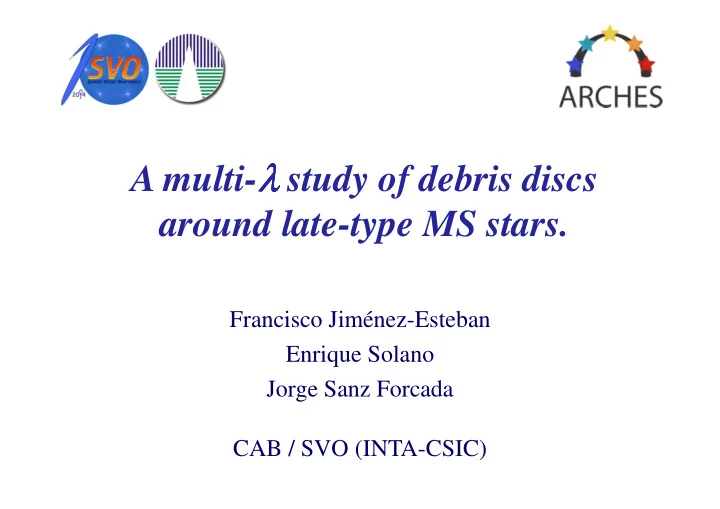

A multi- λ λ λ λ study of debris discs around late-type MS stars. Francisco Jiménez-Esteban Enrique Solano Jorge Sanz Forcada CAB / SVO (INTA-CSIC)
Debris discs around late stars Outline • Science case: Debris disk around late-type MS stars • The workflow • Some preliminary results 2
Debris discs around late stars Science case • Young stars are fast rotators (heritage of the parental cloud) • For late-type (F-M) stars, the rotation produces a dynamo mechanism which is responsible of the coronal activity, and consequently, the X-ray emission. • The younger the star is, the faster it rotates, and the stronger its X-ray emission is. • So, stellar age can be estimated from F x /F bol (Sanz-Forcada et al 2010) 3
Debris discs around late stars Science case • Debris discs are the equivalents of the Kuiper Belt • Typical SEDs with infrared excess • It is expected that the fractional emission F disc /F bol of the debris discs decreases with the stellar age • Main goals: • Study the evolution of debris discs (IR) with the stellar age (X-ray) • Discovery of new debris disk candidates 4
Debris discs around late stars Workflow • Select galactic objects from the ARCHES cross-correlated catalogues by proper motion filtering • Identify IR excess from the SEDs • Obtain F bol (F star ) from atmosphere model fitting • Obtain F disc from black body fitting • Study the relation F x /F bol vs. F disc /F bol 5
Debris discs around late stars Workflow validation • Tested with a sample of warm debris disc candidates around late- type stars (Fujiwara et al. 2013, A&A, 550, A45). • We detected the infrared excess and recovered the physical properties for the star and the disk for most of them. Star Disc 6
Debris discs around late stars Preliminary results 1. Select galactic objects from the ARCHES cross-correlated catalogues by proper motion filtering • 108,037 sources not affected by bright star or galaxy from 3XMMe catalogue • 10713 with pm in UCAC4, good photometry and star flag Selected 5819 with pm > 3 σ pm • • Removed 342 known objects with a classification different than single star in SIMBAD 7
Debris discs around late stars Preliminary results 2. Identify IR excess from the SEDs • Use VOSA to build the SEDs with VO photometry VO SED Analyzer • Automatic detection of 439 infrared excess candidates • 18 known (>2 references) • 54 with one or two references • 367 completely unknown. V4046 Srg: T Tauri HD141133: Debris cand 8
Debris discs around late stars Preliminary results 2. Identify IR excess from the SEDs Visualize all 439 infrared excess candidates with Aladin • galaxies 9
Debris discs around late stars Preliminary results 2. Identify IR excess from the SEDs Visualize all 439 infrared excess candidates with Aladin • galaxies • contaminated fluxes 10
Debris discs around late stars Preliminary results 2. Identify IR excess from the SEDs Visualize all 439 infrared excess candidates with Aladin • galaxies • contaminated fluxes • misidentifications 11
Debris discs around late stars Preliminary results 2. Identify IR excess from the SEDs Compare cleaned VOSA’s SEDs with ARCHES’ SEDs Good agreement in general, but high pm sources Final sample of 244 infrared excess sources 12
Debris discs around late stars Preliminary results 3. Obtain stellar parameters (T eff , F bol , ….) • BT-Settl atmosphere model fitting 13
Debris discs around late stars Preliminary results 4. Obtain F disc from black body fitting • Subtract atmospheric model fluxes from observed fluxes for points with excess • Fit the subtracted photometry with a BB, obtaining T BB and F disk 14
Debris discs around late stars Summary • We have defined and validated a workflow • We have detected 244 X-ray sources with IR-excess • Most of them are unknown • Several debris disc candidates. 15
Debris discs around late stars Thanks 16
Recommend
More recommend